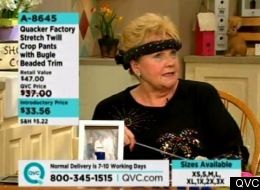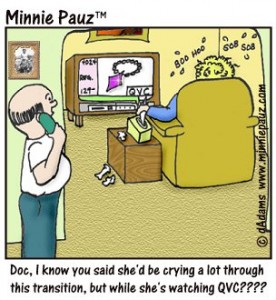Quirks, Viewers, Commerce are the Real QVC
 It’s the butt of jokes, and relegated to the list of channels most TV viewers skip over without ever stopping (unless it’s for a quick eye-roll), but I say there’s more to QVC than cheery hosts, celebs hawking products, blooper fodder for The Soup and comedic inspiration for MadTV. In fact, to my mind, the most fascinating parts of QVC come down to its value as a moneymaking commodity, and its relationship to viewers…and, OK, its quirkiness, which outsiders poke fun at and insiders find charming and endearing.
It’s the butt of jokes, and relegated to the list of channels most TV viewers skip over without ever stopping (unless it’s for a quick eye-roll), but I say there’s more to QVC than cheery hosts, celebs hawking products, blooper fodder for The Soup and comedic inspiration for MadTV. In fact, to my mind, the most fascinating parts of QVC come down to its value as a moneymaking commodity, and its relationship to viewers…and, OK, its quirkiness, which outsiders poke fun at and insiders find charming and endearing.
Founded in 1986, QVC (which stands for Quality, Value, Convenience), broadcasts live 24 hours a day, 364 days a year (every day except Christmas). According to the official website, QVC reaches 96% of American cable homes, and more than 166 million homes worldwide.
Home shopping channels have always been big moneymakers, and QVC claims to be the biggest of them all, beating out competitors like HSN, ShopNBC, and that weird knife channel. In 2008, USA Today reported that QVC “revenue rose 5% in 2007 to $7.4 billion” from 2006, with an “average yearly growth from 2001 through 2006 of 12.3%.” Having long held prime real estate on the TV dial (USA Today reports 80% below channel 35), millions of viewers pass through the QVC lineup every day, which allows them to sell thousands (approximately 1150 unique items per week) of competitively-priced products quickly and widely. The channel claims its record sales day to be December 2, 2001, with over $80 million in orders taken.
Although present in virtually all American homes, most of their sales (95%) come from repeat customers–approximately 1.8 million viewers. Independent research firm BIGresearch counts the average viewer age at 53, and QVC would prefer for it to be lower. By offering new product lines developed by celebrities (Heidi Klum, Ellen Degeneres, Elisabeth Hasselbeck, Whoopi Goldberg, to name a few), famous designers (Bob Mackie, Kathy VanZeeland, Tacori, Isaac Mizrahi, and Project Runway winner Chloe Dao, for example), and well known beauty industry insiders (Bare Escentuals, Philosophy, Laura Geller, Wen, and Ojon, among others), the channel is clearly attempting to develop a younger audience base. And whether young or old, the audience is predominantly female (to the extent that hosts often refer to the home audience as “ladies” and suggest that viewers buy items “for your husband”) and that these women are either stay-at-home or work-from-home moms, housewives, or retirees. 
This recognition of the typical QVC viewer (and customer, remember) and also the channel’s liveness lead to a very interesting interaction between hosts and audiences. The format of QVC programming is very collegial, warm and interactive. Hosts use direct address and look directly into cameras (and ostensibly to each viewer, personally). They discuss what home viewers may or may not be doing at a given moment (“Take a break from those chores, because you won’t want to miss a moment of this hour!”). They mention things that are happening live (the recent snowstorms in Pennsylvania hit the QVC headquarters, so they offered live exterior shots of the campus and suggested viewers experiencing the storm “Stay inside and shop with us!”). They take countless phone calls from viewers, who express satisfaction with the featured product or their excitement over ordering it. This friendly and surprisingly intimate set-up leads audience members to express familiarity with the channel and its hosts, saying, “You keep me company all day!” or “I’ve watched you for 20 years!” I’ve even witnessed one caller telling host Leah Williams, “When you talk to me, it’s like my best friend is talking to me.”
And it is, perhaps, this element of QVC viewership that means the most to me, as a fan. That I have gotten to know the hosts, the rhythms of the channel, the regular guests (designers, representatives), and that what I’m watching is being watched at that moment, live, with others around the country. Yes, there are some bizarre items, some amusing bloopers, some ridiculous gimmicks (David Venable’s famous “Yum!” face is at 1:30), and lots of folksy cheer. But it’s the channel’s embrace of these elements that makes it difficult for insiders to mock. There’s certainly more to QVC than meets the eye, and the channel represents a really fascinating segment of television that most scholars simply aren’t watching.



You’ve hit the nail on the head regarding QVC. I have enjoyed watching for years, and sometimes feel like the hosts are old friends. Great read, thanks!
Great post, Erin. (Although I think the only time I watched QVC for more than a couple of minutes was when I was 12 and Mark Hamill was selling lightsabers or something.)
The USA TODAY link raises an interesting question. QVC pays a fortune for its “prime real estate”, as you put it — its low channel number. The idea is that you flip past it while on the way to watch something else, some awesome item (or celebrity) on QVC catches your eye, and suddenly you’re on the phone with your credit card in hand.
In that USA TODAY article, a former QVC marketing exec wonders if this strategy still works in today’s “on-demand” TV landscape. Beyond that, I wonder if people are still channel-surfing like they used to. With digital cable and satellite TV, you browse using the on-screen guide, so you’re not really getting a look at what they’re selling on QVC.
I’m sure it’s still preferable for QVC to be channel 4 (like in Madison) than snuggled amongst the digital music channels in the 200s, but I wonder if QVC will have additional trouble attracting new customers as more people switch to digital cable and satellite.
Great point, Brad, and I think you’re absolutely right. The prime real estate is still prime, but perhaps losing value a bit. Though I would argue that, even if we’re not channel surfing like we used to (moving through each channel in such a way that we actually see the content for a split second), we are surfing through our digital guides. So when you see “Bare Escentuals” or “Home Cooking with Paula Deen” listed in the guide, you might be more likely to then visit the channel. And I know I end up scrolling through the offerings from channels 2-70 much more than anything higher.
Nonetheless, you’re right that the model is changing. QVC seems to be attempting to develop other methods to get our attention, including placing ads on other channels–something I don’t ever recall seeing prior to a couple of years ago. So now you could be watching Project Runway (or whatever) and see an ad for QVC. That’s definitely new and marks an attempt to move away from the channel surfing model you describe so nicely above.
[…] (For a useful example of the type of analysis I’m suggesting, see this blog entry about QVC.) […]
I admittedly don’t watch much home shopping (and no QVC, being located north of the border), but I think it’s interesting to see two examples of these types of channels gaining some foothold in other series.
On the reality side, ABC’s Shark Tank has Kevin Harrington, who runs the Home Shopping Network, as one of its “Sharks” who offers business opportunities to entrepreneurs. I was admittedly a bit thrown when he started talking about how big certain products would be on television, as I hadn’t really thought of that as a true 21st-century way to sell products.
And on the drama side, Margene on Big Love has transitioned into a new career as a personality on a QVC-like channel, and the negotiation of her on-screen persona has become a plot point as she deals with the rest of her family drama.
In both examples, these channels are held to a fairly high standard: Margene rakes in the dough, viewership is high, and Kevin is a huge success story. Sure, it’s in the best interest (or the sole interest) of both shows to establish that sort of image of home shopping, but it’s interesting that despite my initial skepticism I sort of bought it at the end of the day.
Thanks for sharing these examples, Myles. I don’t watch Shark Tank and I’m behind on Big Love (no HBO), so I hadn’t come across them. Your analysis of them is very interesting! It is rather astonishing to realize just how profitable these enterprises are–$80 million in orders in a single day (even if that is the record) is nothing to sneeze at, certainly.
Actually, the issue of the profitability and viability of selling products on television brings to mind the series Pitchmen, which followed =Anthony “Sully” Sullivan and the late Billy Mays, highly regarded (and very successful) infomercial hosts. Truly, if there’s any TV format more denigrated than home shopping, it’s got to be the infomercial, and yet that series demonstrated how incredibly successful and lucrative the field actually is!
It’s true that QVC always gives me a warm and interactive feel, and my parents LOVE those home shopping channels and can watch them all day on weekend.